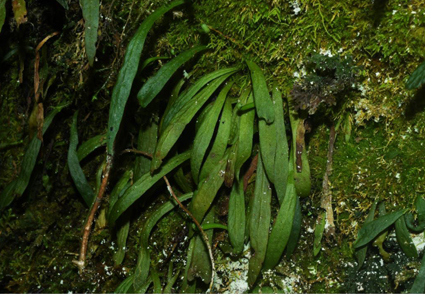Abstract
Loxogramme yigongensis, so far known only from the type specimens collected in 1965 and treated as a synonym of L. grammitoides, is reinstated. Morphologically, these two species are closely related but L. yigongensis differs in having succulent lamina, becoming rugose when dry, lamina lanceolate with acute apex, widest near middle of lamina, and costa not or slightly raised on lower surface. Molecular analyses based on five plastid loci resolved these two species as sister to each other with distinct divergence. In addition, the ploidy level of the two species are reported for the first time.
References
Blume, C. (1828) Enumeratio plantarum Javae et insularum adjacentium, vol. 2. J.W. van Leeuwen, Lugduni Batavorum [Leiden].
Chang, Y.-L. (1963) Studies in the spore morphology of Loxogramme Presl. Journal of Integrative Plant Biology 11: 27–37.
Ching, R.-C. (1929) Some new species of ferns from Kwangsi, China. Sinensia 1: 1–14.
Christensen, C. (1917) Index Filicum, supplement préliminaire pour les annés 1913, 1914, 1915, 1916. H. Hagerup, Hafniae [Copenhagen].
Christensen, C. (1934) Index Filicum–Supplementum tertium (1917–1933). H. Hagerup, Hafniae [Copenhagen].
Fraser-Jenkins, C., Gandhi, K., Kholia, B. & Kandel, D. (2021) An annotated checklist of Indian pteridophytes Part-3 (Lomariopsidaceae to Salviniaceae). Bishen Singh Mahendra Pal Singh, Dehra Dun.
Hall, T.A. (1999) BioEdit: a user-friendly biological sequence alignment editor and analysis program for Windows 95/98/NT. Nucleic Acids Symposium Series 41: 95–98.
Hassler, M (2022) World Ferns. Synonymic checklist and distribution of ferns and lycophytes of the World. Version 12.11. Available from: www.worldplants.de/ferns/ (accessed 22 April 2022)
IUCN. (2021) The IUCN Red List of Threatened Species, version 2021-3. IUCN Red List Unit, Cambridge U.K. Available from: https://www.iucnredlist.org/resources/categories-and-criteria (accessed 25 March 2022)
Kato, M., Nakato, N., Cheng, X. & Iwatsuki, K. (1992) Cytotaxonomic study of ferns of Yunnan, southwestern China. Journal of Plant Research 105: 105–124.
Katoh, K. & Standley, D.M. (2013) MAFFT multiple sequence alignment software version 7: improvements in performance and usability. Molecular Biology and Evolution 30: 772–780. https://doi.org/10.1093/molbev/mst010
Kreier, H. & Schneider, H. (2006) Reinstatement of Loxogramme dictyopteris for a New Zealand endemic fern known as Anarthropteris lanceolata based on phylogenetic evidence. Australian Systematic Botany 19: 309–314. https://doi.org/10.1071/SB05033
Liang, Z.-L., Zhang, L., Gao, X.-F. & Zhang, L.-B. (2021) Chromosome study of 38 fern species in Dryopteridaceae, Hypodematiaceae, Polypodiaceae, and Pteridaceae from China. Indian Fern Journal 38: 198–218.
Linnaeus, C. (1753) Species Plantarum, vol. 2. Imprensis Laurentiii Salvii, Stockholm.
Miller, M.A., Pfeiffer, W. & Schwartz, T. (2010) Creating the CIPRES Science Gateway for inference of large phylogenetic trees. In: Proceedings of the Gateway Computing Environments Workshop (GCE), 14 November 2010. New Orleans, LA, pp. 1–8. https://doi.org/10.1109/GCE.2010.5676129
Park, S.H., Kim, J.S. & Kim, H.T. (2020) Study of the independent gametophytes found on Jeju Island in South Korea and the first record of the obligate independent gametophyte of Antrophyum obovatum Baker. Ecology and Evolution 10: 7826–7838. https://doi.org/10.1002/ece3.6510
PPG I. (2016) A community – derived classification for extant lycophytes and ferns. Journal of Systematics and Evolution 54: 563–603. https://doi.org/10.1111/jse.12229
Presl, C.B. (1836) Tentamen Pteridographiae. T. Haase, Prague.
Rambaut, A. & Drummond, A.J. (2007) Tracer 1.4. Available from: http:// beast.bio.ed.ac.uk/Tracer (accessed 18 July 2022)
Ronquist, F. & Huelsenbeck, J.P. (2003) MrBayes 3: Bayesian phylogenetic inference under mixed models. Bioinformatics 19: 1572–1574.
Rosenstock, E. (1917) Filices palaeotropicae novae herbarii Lugduno-Batavi. Mededeelingen van’s Rijks Herbarium, Leiden 31: 1–8.
Smith, J. (1846) An enumeration of ferns cultivated in the royal gardens at Kew, in December 1845: with characters and observations on some of the genera and species. Curtis’s Botanical Magazine 72: 7–39.
Stamatakis, A., Hoover, P. & Rougemont, J. (2008) A rapid bootstrap algorithm for the RAxML Web servers. Systematic Biology 57: 758–771. https://doi.org/10.1080/10635150802429642
Thiers, B. (2020) Index herbariorum: a global directory of public herbaria and associated staff. New York Botanical Garden’s Virtual Herbarium.
Wu, Z.-Y. (1983) Flora Xizangica vol. 1. Science Press, Beijing.
Zhang, L.-B., Comes, H.P. & Kadereit, J.W. (2001) Phylogeny and quaternary history of the European montane/alpine endemic Soldanella (Primulaceae) based on ITS and AFLP variation. American Journal of Botany 88: 2331–2345. https://doi.org/10.2307/3558393
Zhang, X.-C. & Gilbert, G. M. (2013) Loxogramme. In: Wu, Z.-Y., Raven, P.H., Hong, D.-Y. (Eds.) Flora of China. Vols. 2–3: Lycopodiaceae through Polypodiaceae. Science Press & Missouri Botanical Garden Press, Beijing & St. Louis, pp. 761–764.
Zhou, X.-L., Yan, Y.-H., Zhao, G.-H. & Liu, H.-M. (2016) Spore morphology of Loxogramme (Blume) C.Presl and Its taxonomic significance. Plant Science Journal 34: 669–679.


